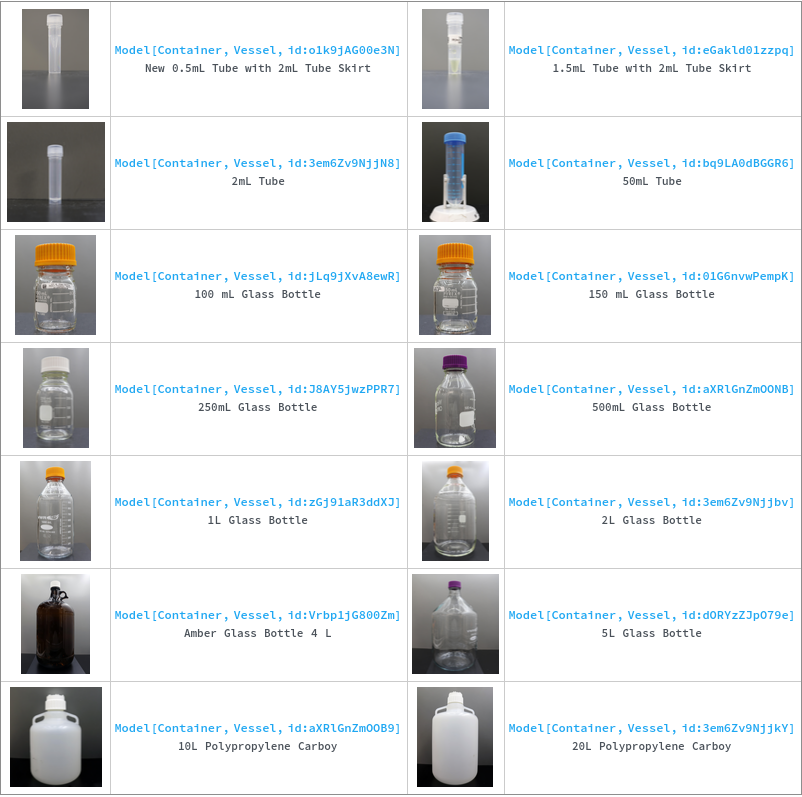LabelSample
LabelSample[Options]⟹UnitOperation
generates an ExperimentSamplePreparation/ExperimentCellPreparation-compatible UnitOperation that labels a sample in a container for use in other primitives.
LabelSample prepares samples and assigns them labels that can be used in other downstream unit operations.
Experimental Principles

Figure 1.1: The LabelSample and LabelContainer unit operations will fulfill requests for samples/containers either by using an existing sample/container, purchasing a sample/container from the ECL inventory, transferring an existing sample into a new requested container, or by making the sample via ExperimentStockSolution. The fulfilled sample or container can then be used downstream by referring to its assigned label.
Instrumentation



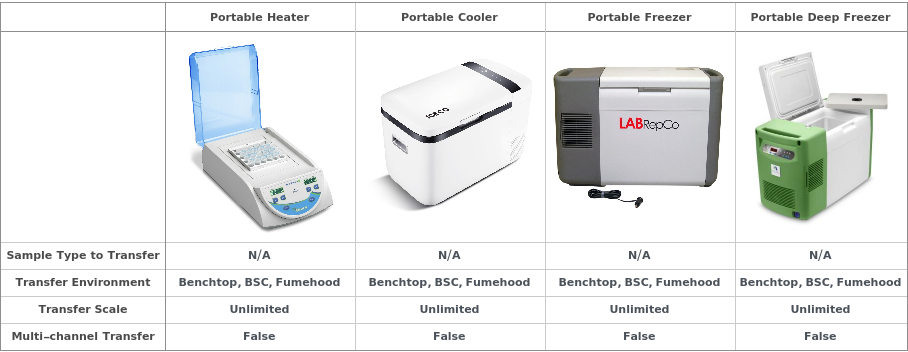
Eppendorf Research Plus P200

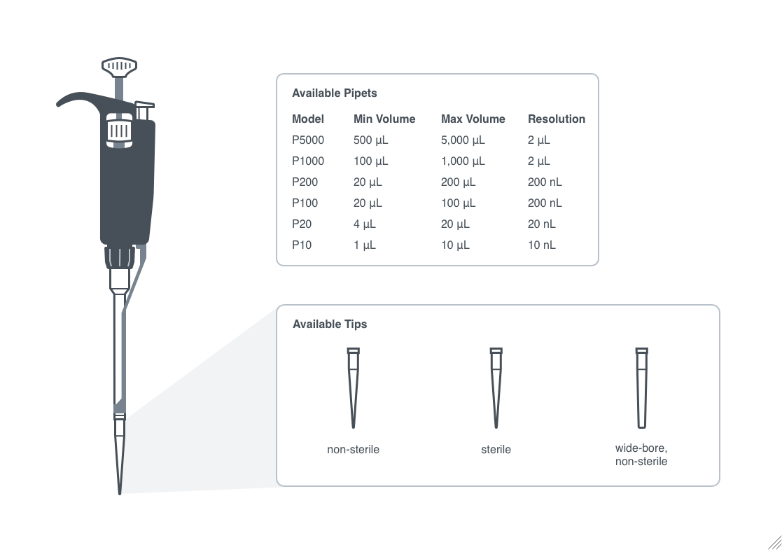
Figure 2.1.1: The diagram above lists the available pipette sizes and corresponding tip types that are available in the ECL.
pipetus

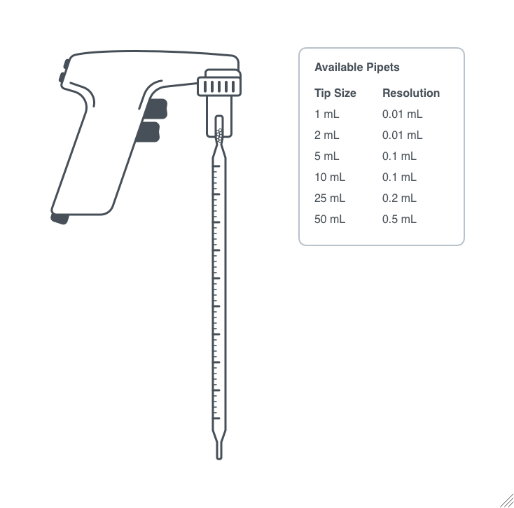
Figure 2.2.1: The above diagram lists the compatible serological tip sizes that are available at the ECL.
Eppendorf Research Plus, 8-channel 100uL

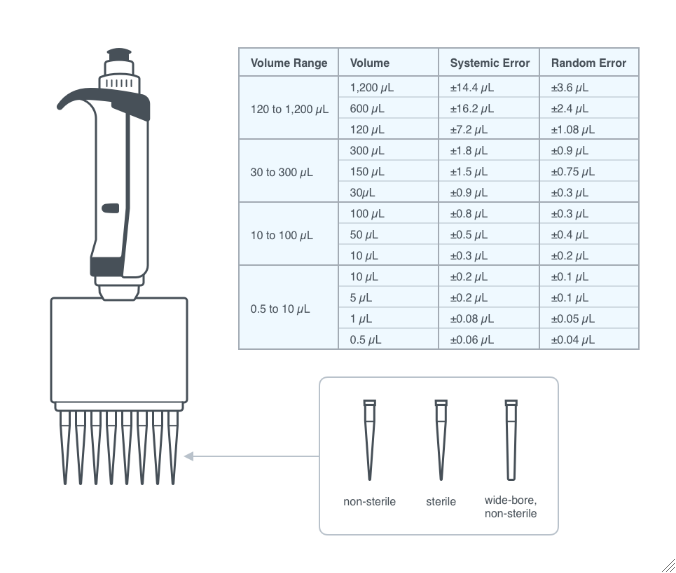
Eppendorf Research Plus, 12-channel 1200uL

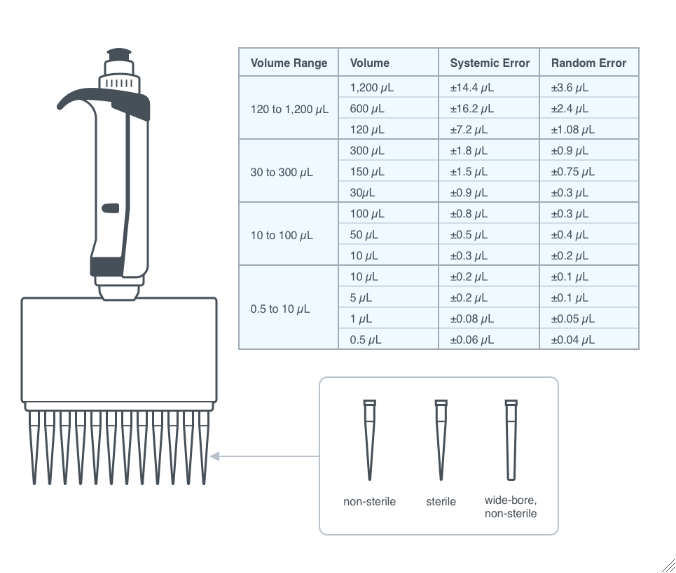
HandEvac Handheld Aspirator, Tissue Culture

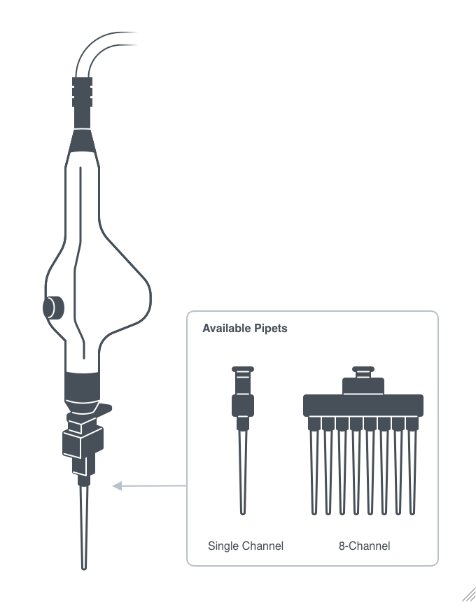
Figure 2.5.1: The aspirator can be used to aspirate any volume from a sample using a single channel or 8 channels. Aspirators are currently only available in the BSC (both Microbial and Tissue Culture) and are used for cell culture applications.
Mettler Toledo XP6

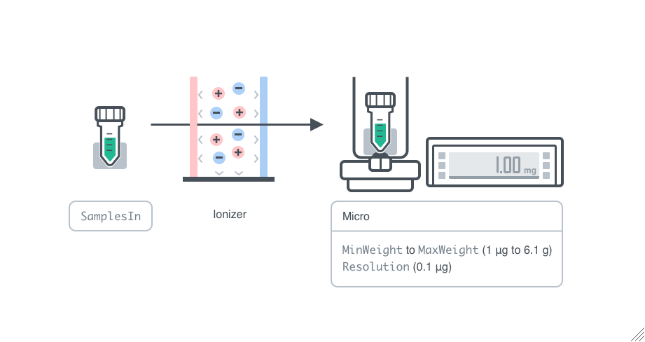
Figure 2.6.1: Items are transferred through an ionizer, which floods the local environment with positive and negative ions. This removes any static electricity that has built up on items and provides a more stable and accurate mass reading.The user must explicitly specify the Micro-Balance using the option Instrument -> Model[Instrument,Balance,"id:54n6evKx08XN"] if so desired.
Ohaus Pioneer PA124

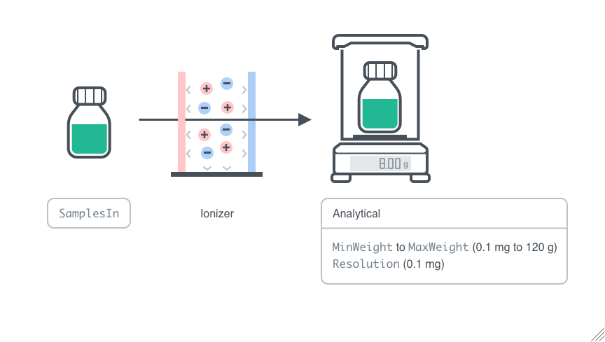
Figure 2.7.1: Items are transferred through an ionizer, which floods the local environment with positive and negative ions. This removes any static electricity that has built up on items and provides a more stable and accurate mass reading.
Ohaus EX6202

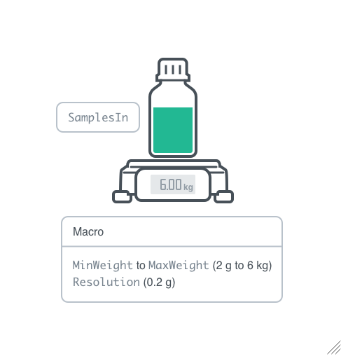
Labconco Premier 5 Foot

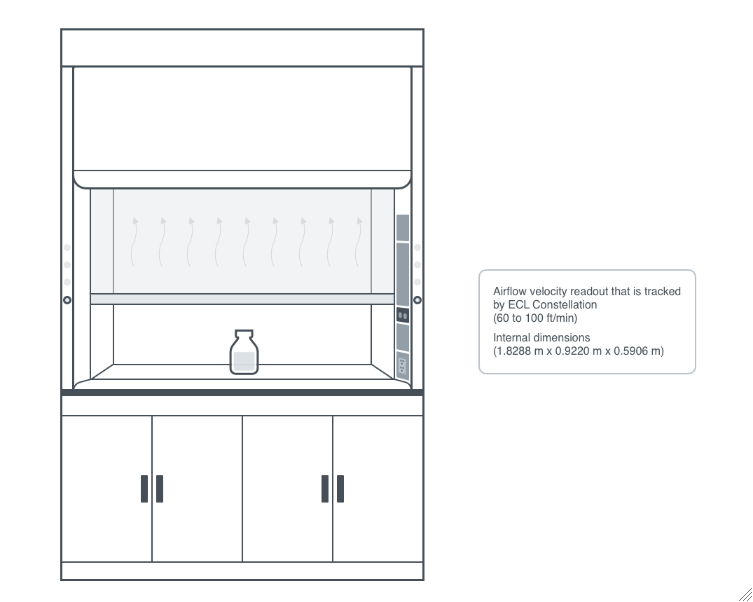
Figure 2.9.1: Fuming samples are automatically routed to use a fume hood as the TransferEnvironment in ExperimentTransfer. Airflow velocity in the fume hood is tracked by ECL Constellation and can be viewed by inspecting the instrument object.
Thermo Scientific 1300 Series Class II, Type A2 Biosafety Cabinet (Tissue Culture)

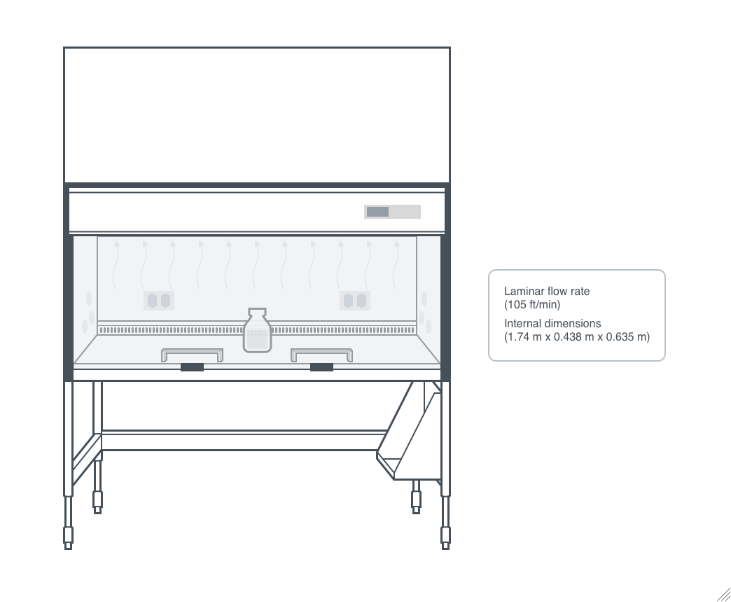
Figure 2.10.1: A biosafety cabinet will be used when transfering into/out of cell samples. Microbial samples must be handeled in the Microbial BSC and Tissue Culture samples must be handeled in the Tissue Culture BSC (specified by the CultureHandling field in the Model[Instrument, BiosafetyCabinet]). All biosafety cabinets have a full set of micropipettes, serological pipette, sterile cooler, sterile heater, aspirator, and analytical balance.
Thermo Scientific 1300 Series Class II, Type A2 Biosafety Cabinet (Microbial)


Figure 2.11.1: A biosafety cabinet will be used when transfering into/out of cell samples. Microbial samples must be handeled in the Microbial BSC and Tissue Culture samples must be handeled in the Tissue Culture BSC (specified by the CultureHandling field in the Model[Instrument, BiosafetyCabinet]). All biosafety cabinets have a full set of micropipettes, serological pipette, sterile cooler, sterile heater, aspirator, and analytical balance.
NexGen Glove Box

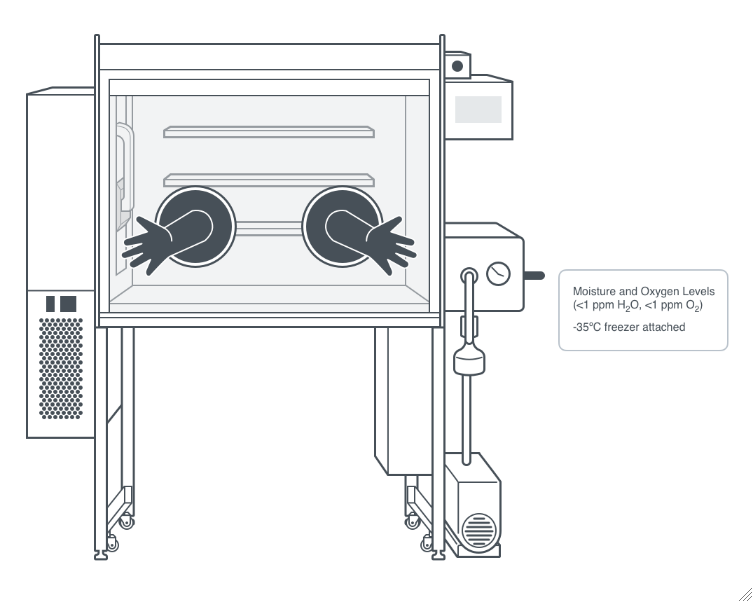
Figure 2.12.1: The glove box can be used to perform transfers under an inert atmosphere. Note that certain samples (InertCatalystIncompatible->True) cannot be used inside of the glove box. This is because some samples that contain sulfur and sulfur compounds (such as H2S, RSH, COS, SO2, SO3) deactivate the catalyst that is used in the glove box to remove traces of water and oxygen. Large quantities of halides, chlorides, halogen (Freon), alcohol, hydrazine, phosphene, arsine, arsenate, mercury, and saturation with water may also deactivate the catalyst.
Main Lab Portable Heater

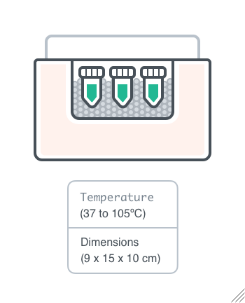
Figure 2.13.1: Containers are placed in the main compartment of the portable heater. The portable heater is filled with lab armor beads to ensure that the entire container is heated to the correct temperature.
ICECO GO20 Portable Refrigerator

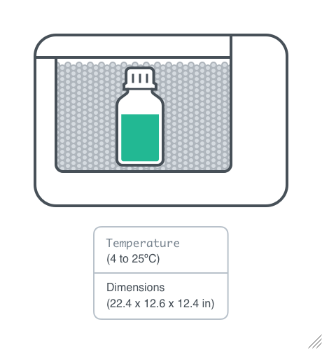
Experiment Options
General
Label
Restricted
Indicates whether the sample should be restricted from automatic use is any of your team's experiments that request the sample's models. (Restricted samples can only be used in experiments when specifically provided as input to the experiment functions by a team member). Setting the option to Null means the sample should be untouched. Setting the option to True or False will set the Restricted field of the sample to that value respectively.
Sample
Programmatic Pattern: (ObjectP[{Model[Sample]}] | (ObjectP[{Object[Sample]}] | _String) | {Alternatives @@ Flatten[AllWells[NumberOfWells -> 384]] | LocationPositionP, ObjectP[{Object[Container]}] | _String}) | Automatic
Container
Default Calculation: Automatically resolves to an Object[Container] if an Object[Sample] is specified. Otherwise, automatically resolves to a Model[Container] on any existing samples that can be used to fulfill the Model[Sample] request or based on the container that the default product for the Model[Sample] comes in.
Programmatic Pattern: ((ObjectP[Object[Container]] | _String) | ObjectP[Model[Container]]) | Automatic
Well
ContainerLabel
Amount
Programmatic Pattern: ((Null | (GreaterP[0*Milligram] | GreaterP[0*Milliliter] | GreaterEqualP[1, 1])) | Automatic) | Null
ExactAmount
Indicates that an Object[Sample] with the exact Amount specified (+/- Tolerance) should be picked in the lab. If set to False, existing samples with an amount greater than or equal to the amount requested can be used. ExactAmount should be set to True if you are depending on the sample having an exact volume/mass/count in the lab. However, if you're just transferring out of this sample and don't care about its exact volume, setting ExactAmount->False will save time in the lab (the exact amount doesn't need to first be aliquotted out).
Default Calculation: Automatically set to True if the sample has FixedAmounts or if the user has manually specified the Amount option.
Tolerance
The allowed tolerance when preparing the specified Amount of sample. This option can only be set if ExactAmount is set to True.
Programmatic Pattern: ((Null | (GreaterP[0*Milligram] | GreaterP[0*Milliliter] | GreaterEqualP[1, 1] | RangeP[0*Percent, 100*Percent])) | Automatic) | Null
Preparation
Indicates if this unit operation is carried out primarily robotically or manually. Manual unit operations are executed by a laboratory operator and robotic unit operations are executed by a liquid handling work cell.
Health & Safety
SampleModel
Specifies the model of the given sample. This option should only be used if you want to override the proper Model[Sample] of your labeled sample.
State
SampleHandling
The method by which this sample should be manipulated in the lab when transfers out of the sample are requested.
Pattern Description: Liquid, Slurry, Powder, Itemized, Viscous, Paste, Brittle, Fabric, Fixed, AdherentCells, SuspensionCells, or SolidColonies or Null.
CellType
CellCultureType
Sterile
Anhydrous
ExpirationDate
Date after which this sample is considered expired and users will be warned about using it in protocols.
InertHandling
BiosafetyHandling
RNaseFree
NucleicAcidFree
PyrogenFree
Radioactive
Ventilated
Pungent
Flammable
Acid
Indicates if pure samples of this molecule are strong acids (pH <= 2) and require dedicated secondary containment during storage.
Base
Indicates if pure samples of this molecule are strong bases (pH >= 12) and require dedicated secondary containment during storage.
Pyrophoric
WaterReactive
Fuming
HazardousBan
Indicates if pure samples of this molecule are currently banned from usage in the ECL because the facility isn't yet equiped to handle them.
ExpirationHazard
Indicates if pure samples of this molecule become hazardous once they are expired and must be automatically disposed of when they pass their expiration date.
ParticularlyHazardousSubstance
Indicates if special precautions should be taken in handling this substance as indicated by the MSDS classification.
DrainDisposal
MSDSRequired
MSDSFile
Pattern Description: A cloud file stored on Constellation that ends in .PDF or a string that matches the pattern: URLP or Null.
NFPA
The National Fire Protection Association (NFPA) 704 hazard diamond classification for the substance.
Programmatic Pattern: (Null | (Null | {0 | 1 | 2 | 3 | 4, 0 | 1 | 2 | 3 | 4, 0 | 1 | 2 | 3 | 4, ListableP[Oxidizer | WaterReactive | Aspyxiant | Corrosive | Acid | Bio | Poisonous | Radioactive | Cryogenic | Null] | {}})) | Null
DOTHazardClass
Pattern Description: Class 0, Class 1 Division 1.1 Mass Explosion Hazard, Class 1 Division 1.2 Projection Hazard, Class 1 Division 1.3 Fire, Blast, or Projection Hazard, Class 1 Division 1.4 Limited Explosion, Class 1 Division 1.5 Insensitive Mass Explosion Hazard, Class 1 Division 1.6 Insensitive No Mass Explosion Hazard, Class 2 Division 2.1 Flammable Gas Hazard, Class 2 Division 2.2 Non-Flammable Gas Hazard, Class 2 Division 2.3 Toxic Gas Hazard, Class 3 Flammable Liquids Hazard, Class 4 Division 4.1 Flammable Solid Hazard, Class 4 Division 4.2 Spontaneously Combustible Hazard, Class 4 Division 4.3 Dangerous when Wet Hazard, Class 5 Division 5.1 Oxidizers Hazard, Class 5 Division 5.2 Organic Peroxides Hazard, Class 6 Division 6.1 Toxic Substances Hazard, Class 6 Division 6.2 Infectious Substances Hazard, Class 7 Division 7 Radioactive Material Hazard, Class 8 Division 8 Corrosives Hazard, or Class 9 Miscellaneous Dangerous Goods Hazard or Null.
BiosafetyLevel
Storage Information
StorageCondition
Expires
ShelfLife
The length of time after DateCreated that samples of this model are recommended for use before they should be discarded.
UnsealedShelfLife
The length of time after DateUnsealed that samples of this model are recommended for use before they should be discarded.
TransportWarmed
The temperature at which the sample should be incubated while transported between instruments during experimentation.
Pattern Description: Greater than or equal to 30 degrees Celsius and less than or equal to 105 degrees Celsius or Null.
TransportChilled
Indicates if this sample should be refrigerated while transported between instruments during experimentation.
TransferTemperature
Pattern Description: Greater than or equal to 4 degrees Celsius and less than or equal to 90 degrees Celsius or Null.
LightSensitive
Determines if the sample reacts or degrades in the presence of light and should be stored in the dark to avoid exposure.
Compatibility
GloveBoxIncompatible
Indicates if this sample cannot be used inside of the glove box due high volatility and/or detrimental reactivity with the catalyst in the glove box that is used to remove traces of water and oxygen. Sulfur and sulfur compounds (such as H2S, RSH, COS, SO2, SO3), halides, halogen (Freon), alcohols, hydrazine, phosphene, arsine, arsenate, mercury, and saturation with water may deactivate the catalyst.
GloveBoxBlowerIncompatible
Indicates that the glove box blower must be turned off to prevent damage to the catalyst in the glove box that is used to remove traces of water and oxygen, when manipulating this sample inside of the glove box.
IncompatibleMaterials
Pattern Description: List of one or more None, ABS, PLA, Acrylic, AmorphousFluoropolymer, CPVC, CTFE, Cycloolefine, Delrin, ECTFE, EPDM, ETFE, EVA, FEP, FFKM, HDPE, Hypalon, LDPE, NaturalRubber, NBR, Neoprene, Nitrile, Noryl, Nylon, PEEK, PEI, Perlast, PharmaPure, Polycarbonate, Polyester, Polyethylene, Polyolefin, Polyoxymethylene, Polypropylene, Polystyrene, Polyurethane, PVC, PCTFE, PETG, PF, PFA, PPS, PTFE, PVDF, SEBS, Silicone, SyntheticRubber, TFM, TPE, Tygon, UVPlastic, Viton, Aluminum, Alloy, AnodisedAluminum, Brass, Bronze, CarbonSteel, CastIron, Chrome, Copper, Elgiloy, Gold, Hastelloy, Lead, Magnesium, Molybdenum, Nickel, Niobium, Platinum, Silver, Steel, StainlessSteel, Titanium, Tungsten, Zinc, Cellulose, Cotton, Polyethylene, PTFE, Nylon, PES, PLUS, PVDF, GlassFiber, GHP, UHMWPE, EPDM, DuraporePVDF, GxF, ZebaDesaltingResin, NickelResin, Silica, Silica, ResinParticlesWithLatexMicroBeads, CrossLinkedDextranBeads, CrossLinkedPolystyrene, AerisCoreShell, KinetexCoreShell, CrossLinkedAgarose, Vydac218MS, JordiGel, Styrene, SilicaCompositeTWIN, BEH, CSH, HSS, CarboPacPA1, CarboPacPA10, Polysulfone, AluminiumOxide, ZirconiumOxide, Cardboard, Ceramic, Epoxy, EpoxyResin, Glass, GlassyCarbon, Graphite, OpticalGlass, Porcelain, Quartz, UVQuartz, ESQuartz, FusedQuartz, IRQuartz, Oxidizer, Ruby, Sapphire, Silicon, Silver, Viton, Styrofoam, VacuumMeltedStainlessSteel, or Wood entries or Null.
Programmatic Pattern: (Null | (Null | {(None | ABS | PLA | Acrylic | AmorphousFluoropolymer | CPVC | CTFE | Cycloolefine | Delrin | ECTFE | EPDM | ETFE | EVA | FEP | FFKM | HDPE | Hypalon | LDPE | NaturalRubber | NBR | Neoprene | Nitrile | Noryl | Nylon | PEEK | PEI | Perlast | PharmaPure | Polycarbonate | Polyester | Polyethylene | Polyolefin | Polyoxymethylene | Polypropylene | Polystyrene | Polyurethane | PVC | PCTFE | PETG | PF | PFA | PPS | PTFE | PVDF | SEBS | Silicone | SyntheticRubber | TFM | TPE | Tygon | UVPlastic | Viton | Aluminum | Alloy | AnodisedAluminum | Brass | Bronze | CarbonSteel | CastIron | Chrome | Copper | Elgiloy | Gold | Hastelloy | Lead | Magnesium | Molybdenum | Nickel | Niobium | Platinum | Silver | Steel | StainlessSteel | Titanium | Tungsten | Zinc | Cellulose | Cotton | Polyethylene | PTFE | Nylon | PES | PLUS | PVDF | GlassFiber | GHP | UHMWPE | EPDM | DuraporePVDF | GxF | ZebaDesaltingResin | NickelResin | Silica | Silica | ResinParticlesWithLatexMicroBeads | CrossLinkedDextranBeads | CrossLinkedPolystyrene | AerisCoreShell | KinetexCoreShell | CrossLinkedAgarose | Vydac218MS | JordiGel | Styrene | SilicaCompositeTWIN | BEH | CSH | HSS | CarboPacPA1 | CarboPacPA10 | Polysulfone | AluminiumOxide | ZirconiumOxide | Cardboard | Ceramic | Epoxy | EpoxyResin | Glass | GlassyCarbon | Graphite | OpticalGlass | Porcelain | Quartz | UVQuartz | ESQuartz | FusedQuartz | IRQuartz | Oxidizer | Ruby | Sapphire | Silicon | Silver | Viton | Styrofoam | VacuumMeltedStainlessSteel | Wood)..})) | Null
LiquidHandlerIncompatible
Indicates if pure samples of this molecule cannot be reliably aspirated or dispensed on an automated liquid handling robot.
PipettingMethod
UltrasonicIncompatible
Example Calls
Basic Examples
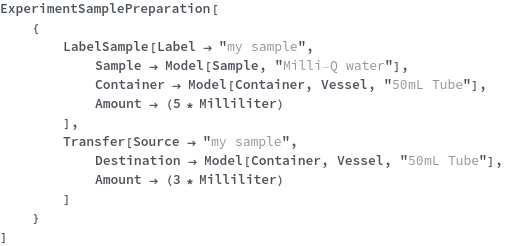
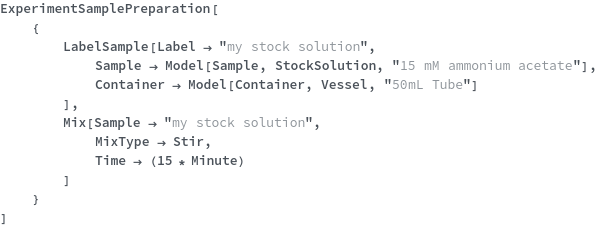
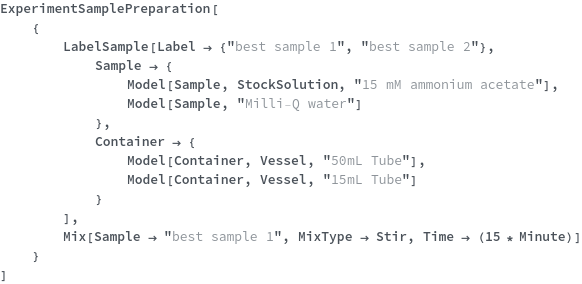
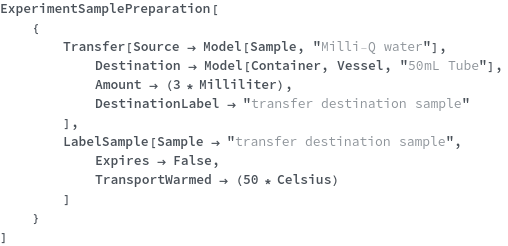
If the Container option isn't specified, it will automatically be set to the smallest Preferred Container that can hold the requested amount of sample:
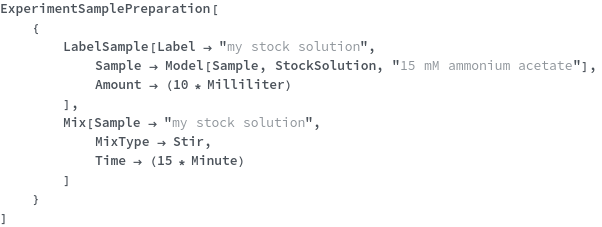
The ExactAmount option is an advanced option that indicates that a sample with a precise Amount must be used for the experiment. If this option is set to False, a sample with MORE than the requested Amount of volume/mass/count can be used by LabelSample (ex. one already exists in inventory) - this can save time in the lab by reducing unnecessary transfers. When the Amount option is set explicitly by the user, the ExactAmount option is always automatically set to True. The criteria of what counts as an "exact match" can also be controlled using the Tolerance option. The following LabelSample unit operation will request for a water sample in a 50mL tube that contains 5mL +/- 10 uL.
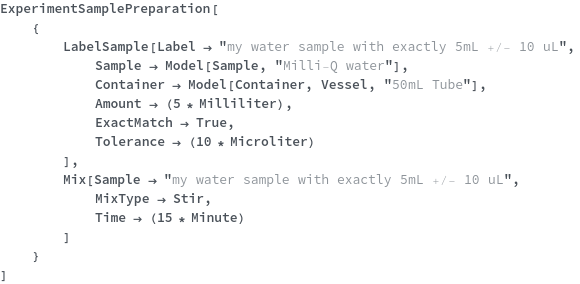
Warnings and Errors
-
Messages
Last modified on Thu 10 Feb 2022 10:25:32
